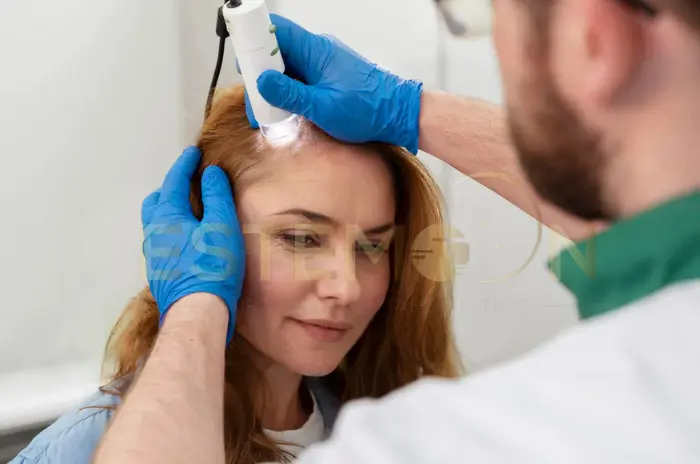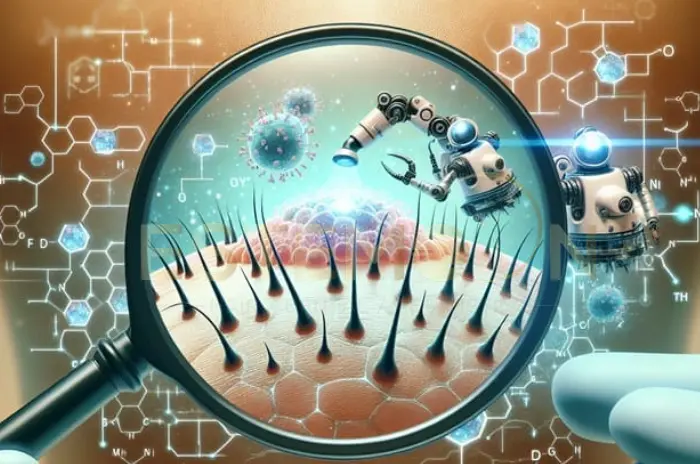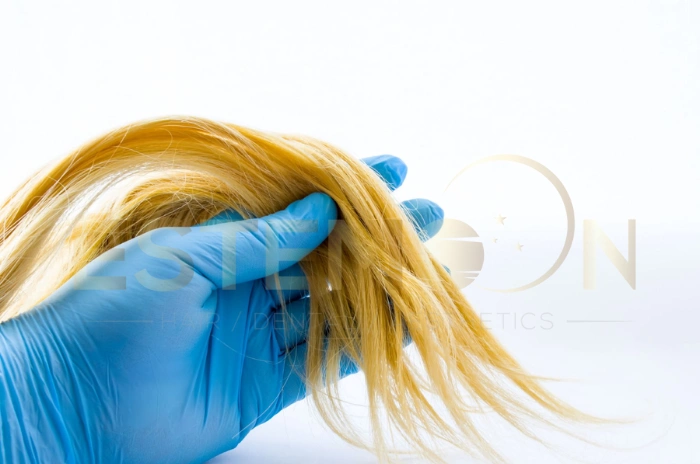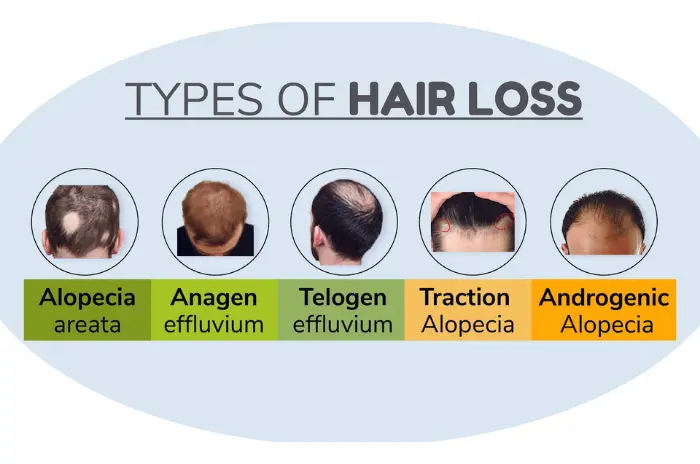At Estemoon intermediary organization, we see growing interest in hair products that use nanotechnology to deliver active ingredients more precisely and comfortably. Nanotechnology, in simple terms, refers to engineering materials at extremely small sizes—often between 1 and 200 nanometers—so they behave differently than their larger counterparts. In hair care and scalp therapy, this can translate into better penetration into the follicular opening, steadier release of ingredients, improved stability of sensitive actives, lighter feel on the scalp, and more consistent results.
This guide explains what nanotechnology means for hair care, how it enhances scalp treatments, which nano-systems are most common, what you can realistically expect in terms of benefits, where the safety conversations stand, and how to select the right nano-based product for your needs. It also includes a practical FAQ section to help you apply this knowledge in day-to-day routines.

What Is Nanotechnology in Hair Care?
In cosmetic science, nanotechnology typically involves creating nanoscale carriers that transport active molecules to where they can work best. Rather than forcing ingredients through the skin barrier, many hair-care nano-systems are designed to settle into the hair follicle opening, coat the hair shaft more uniformly, and release their payloads gradually. The goal is to enhance efficacy while lowering irritation and improving cosmetic elegance.
Common nano-delivery systems you will see on labels include:
Liposomes and niosomes (small vesicles that encapsulate water- or oil-soluble actives)
Nanoemulsions and microemulsions (ultra-fine oil-in-water or water-in-oil droplets)
Solid lipid nanoparticles (SLN) and nanostructured lipid carriers (NLC)
Polymeric nanoparticles and nanogels (biocompatible polymer matrices)
Cyclodextrins (ring-shaped carriers that “host” small molecules)
Micelles (surfactant clusters that solubilize oily actives in water)
At-a-glance: common nano-systems and what they do
| Nano-system | What it is | What it helps with | Typical use cases |
|---|---|---|---|
| Liposomes / Niosomes | Vesicles with a bilayer shell | Protect unstable actives; improve deposition; slow release | Peptides, antioxidants, vitamins, botanical extracts |
| Nanoemulsions | Ultra-fine droplets stabilized by surfactants | Enhance spreadability and absorption; light sensory feel | Caffeine, rosemary extract, menthol, oils |
| SLN / NLC | Solid or semi-solid lipid particles | Occlusive microfilm; sustained delivery; scalp comfort | Anti-inflammatory actives, soothing agents |
| Polymeric nanoparticles | Biocompatible polymer carriers | Targeted delivery; control release profile | Minoxidil alternatives, anti-flake agents |
| Cyclodextrins | Ring molecules trapping actives | Stabilize and mask odor; timed release | Sulfur-based actives, volatile essential oils |
| Micelles | Surfactant clusters | Solubilize oil-soluble actives in watery base | Light serums with low greasiness |
Key point: these systems do not automatically make a product “stronger.” They are tools to optimize where and how an active works, how it feels, and how well you can tolerate it day after day.
How Nanotechnology Enhances Scalp Treatments
Hair and scalp needs vary widely: dandruff-prone scalps need antifungal support; irritated scalps need calming; pattern hair loss benefits from growth-signaling actives that reach the follicular opening. Nanotechnology can help across these situations in four main ways.
Better deposition at the follicular opening
Nano-carriers tend to collect around the follicle infundibulum (the opening), which is where many hair-growth and anti-inflammatory targets reside. This improves “hit rate” without heavy, occlusive layers.Controlled and sustained release
Instead of a rapid burst, nano-systems can release actives over hours. That steadier profile often means less irritation and more consistent signaling.Stability of fragile ingredients
Vitamins, polyphenols, and peptides degrade with heat, light, or oxygen. Encapsulation shields them until they reach the scalp surface.Sensory elegance and compliance
Ultra-fine droplets feel lighter and less greasy, reducing the temptation to abandon the routine. Consistency is a major driver of results.
Problem–solution map for nano-enabled scalp care
| Scalp/hair problem | Why it’s hard to treat | Nano-enabled solution | Expected outcome |
|---|---|---|---|
| Dandruff/seborrhea | Yeast overgrowth; barrier irritation | Encapsulated antifungals or anti-inflammatories | Fewer flakes, less itch, calmer scalp |
| Sensitive scalp | Actives sting or feel heavy | Liposomal soothing agents in light base | Better tolerance, can stay on longer |
| Pattern thinning | Limited follicular deposition; irritation risk | Follicle-targeted nanoemulsions with growth-promoting actives | More consistent signaling with less redness |
| Dry, frizzy hair | Uneven coating; oil build-up | SLN/NLC create thin, even film | Smoother fiber, less frizz, lighter feel |
| Color fade/UV damage | Pigment wash-out; photo-oxidation | UV-screening nanoparticles; anti-oxidants in carriers | Slower color fade; shinier appearance |
3- Key Nanomaterials Used in Hair Care Products
The “nano” in hair care is usually about the carrier system rather than metallic nanoparticles. Here are the most common families you’ll encounter, with practical examples.
Liposomes and niosomes
Phospholipid (liposome) or non-ionic surfactant (niosomal) vesicles that encapsulate both water- and oil-soluble actives.
Typical actives: peptides (including copper peptides), niacinamide, panthenol, caffeine, botanical polyphenols
Use cases: supportive growth serums, soothing scalp essences
Advantages: gentle profile, improved stability and deposition
Nanoemulsions and microemulsions
Sub-200 nm droplets provide a silky, fast-absorbing texture.
Typical actives: caffeine, menthol, rosemary/camellia extracts, adenosine, light oils
Use cases: daily leave-on scalp tonics that don’t weigh down roots
Advantages: uniform spread, good cosmetic elegance
Solid lipid nanoparticles (SLN) and nanostructured lipid carriers (NLC)
Solid or semi-solid lipid particles that form an ultra-thin film on hair/skin.
Typical actives: soothing agents, antioxidants, UV stabilizers, conditioning lipids
Use cases: anti-frizz serums, calming scalp lotions, color-care leave-ins
Advantages: sustained release, improved shine and smoothness
Polymeric nanoparticles and nanogels
Biocompatible polymers form spheres or gels embedding actives.
Typical actives: anti-inflammatory agents, alternative growth promoters, antiflakes
Use cases: targeted scalp treatments with slow release
Advantages: tunable size and release; can reduce irritation
Cyclodextrin complexes
Ring-shaped molecules that “host” small actives to improve stability and odor profile.
Typical actives: sulfur compounds, certain essential oils, volatile botanicals
Use cases: anti-flake tonics that need odor masking and gradual release
Advantages: better sensorial acceptance; controlled evaporation
Micelles
Surfactant spheres solubilize lipophilic actives in water.
Typical actives: light oils, vitamins, fragrance-free formulations
Use cases: watery, sprayable scalp serums
Advantages: light feel, easy layering with other products
Quick reference: nanomaterials in practice
| Carrier or complex | Typical actives | Primary role | Good for | Notes |
|---|---|---|---|---|
| Liposome/Niosome | Peptides, antioxidants, caffeine | Stabilize and deliver | Sensitive scalp, nightly serums | Often fragrance-reduced; good tolerance |
| Nanoemulsion | Caffeine, adenosine, light oils | Spreadability and feel | Daily leave-ons, oily roots | Avoid over-fragrance in reactive scalps |
| SLN/NLC | Soothing actives, lipids | Thin protective film | Frizz control, color care | Helps with smoothness without heavy oils |
| Polymeric NP/Nanogel | Anti-inflammatory actives | Controlled release | Persistent redness/itch | Used in targeted scalp fluids |
| Cyclodextrin | Odor-prone or volatile actives | Odor masking, timed release | Anti-flake blends | Can improve compliance |
| Micelles | Lipophilic vitamins, light oils | Water-light textures | Fine hair types | Minimal residue if well-formulated |

Benefits of Nanotechnology for Hair Health
When well formulated, nano-based products can offer tangible benefits that you can see and feel within realistic timelines.
Improved delivery to the scalp surface and hair follicle entrance
More even coating along the fiber for smoother, shinier hair
Timed release that maintains effect between washes
Lower irritancy by buffering strong actives within gentle carriers
Lighter, cleaner finish that supports daily compliance
Potential for better color longevity and UV protection in leave-ins
Who benefits and how
| User scenario | Pain point | Nano-driven benefit | What you may notice |
|---|---|---|---|
| Early pattern thinning | Irritation from leave-ons; poor consistency | Follicle-focused delivery with gentler feel | Better tolerance of nightly serums; steadier progress |
| Dandruff-prone scalp | Flake return after a few days | Sustained delivery of soothing/anti-yeast actives | Itch/flake control lasts longer between washes |
| Fine, easily weighed-down hair | Oils make roots flat | Ultra-light nanoemulsions | Cleaner lift at roots; less buildup |
| Bleached/colored hair | Frizz, color fade | SLN/NLC film and antioxidants | Smoother cuticle; slower fade; more shine |
| Sensitive, reactive scalp | Burning/stinging with actives | Encapsulation and low-fragrance bases | Higher comfort; fewer drop-offs from routines |
Potential Risks and Safety Considerations
Nanotechnology in cosmetics is generally formulated to act on the surface and within the follicular opening, not to penetrate live skin deeply. Still, safety is about details: particle type, size, coating, concentration, and how a product is used.
Key considerations:
Particle size and composition
The vast majority of hair-care nano-systems are soft carriers (lipid vesicles, emulsions, polymers), not hard inorganic particles. They are designed to deposit and release actives locally.Irritation potential comes mostly from bases and fragrance
Alcohol-heavy or highly fragranced formulas can irritate, regardless of nano-status. Fragrance-smart, low-alcohol bases tend to be better tolerated.Photoreactivity and coatings
When mineral UV screens or pigments are nanonized in leave-ins, reputable brands use coated forms to minimize unwanted photochemistry and keep particles on the surface.Inhalation risk with sprays
Avoid inhaling aerosols or powders, nano or not. Opt for pump sprays or dropper serums applied close to the scalp.Regulatory and labeling
Many regions require disclosure if a listed ingredient is in nano form. Look for transparent INCI listings and responsible claims.
Practical safety table
| Potential risk | What it looks like in real life | How to minimize |
|---|---|---|
| Irritation from vehicle | Redness, itch, tightness after use | Choose low-fragrance, low-alcohol serums; patch test behind ear 48 hours |
| Build-up and dullness | Flat roots, residue | Use the minimal amount; clarify or rotate gentle shampoos |
| Over-exfoliation | Flaking, stinging | Limit acid-based scalp products to 1–2 nights/week |
| Inhalation of sprays | Coughing, throat irritation | Prefer pumps/droppers; apply close to scalp; ventilate room |
| Misaligned expectations | Disappointment after 2–3 weeks | Allow 8–12 weeks before judging; track with consistent photos |
If you have dermatologic conditions, allergies, or are pregnant/breastfeeding, review ingredients with a qualified professional before starting a new active routine.
How to Choose Nanotechnology-Based Hair Products
Picking a product is easier when you match the carrier and actives to your specific goals and scalp type.
Step-by-step:
Define the primary goal
Is it flake control, growth support, frizz reduction, or color protection? Choose actives accordingly.Pick the right carrier feel
Oily scalp or fine hair often prefers nanoemulsions or micelles. Dry/frizzy hair likes SLN/NLC films. Sensitive scalps may do best with liposomal serums.Check the base and fragrance
Look for fragrance-smart, alcohol-moderate bases to reduce stinging and dropout.Build a simple routine first
Start with one nano-serum and a compatible shampoo/conditioner. Add new products one at a time every two to three weeks.Track objectively
Use the same lighting and angles for photos every four to six weeks. Adjust only after a full 8–12 week trial.
Matching guide by hair/scalp type
| Hair/scalp profile | Primary need | Suggested nano-systems | Example actives | Routine notes |
|---|---|---|---|---|
| Oily, flaky scalp | Calm flakes and redness | Micelles, nanoemulsions, cyclodextrin complexes | Piroctone olamine, zinc, soothing botanicals | Combine with antifungal shampoo days for best access |
| Dry, sensitive scalp | Comfort and barrier support | Liposomes/niosomes; SLN with soothing lipids | Niacinamide, panthenol, peptides | Avoid strong acids; keep fragrance low |
| Fine, easily weighed-down hair | Lightweight lift | Nanoemulsions and micelles | Caffeine, adenosine, light antioxidants | Minimal dosage; avoid heavy silicones at roots |
| Curly/coarse/frizzy hair | Smoothing and humidity control | SLN/NLC leave-ins | Lipids, ceramides, film-formers | Even application mid-lengths to ends |
| Early pattern thinning | Consistent follicular signaling | Nanoemulsions or liposomes | Caffeine, adenosine, peptides | Consider pairing with proven growth actives as advised |
| Color-treated hair | Color longevity and shine | SLN/NLC with antioxidants and UV filters | Vitamin E, UV screens, quaternized polymers | Rinse cool; limit heat; protect in sun |
FAQ
How does nanotechnology help hair growth?
Nanotechnology helps by improving how growth-supporting actives are deposited and retained near the follicular opening, where they can do the most good. Encapsulation also buffers potential irritants, which keeps you using the product consistently—arguably the biggest predictor of success. Expect supportive effects such as better comfort, steadier signaling, smoother fibers, and reduced wash-off, rather than an instant regrowth effect.
Are hair products with nanoparticles safe?
For leave-on hair and scalp products, the nano-systems used are typically soft carriers like liposomes, nanoemulsions, or lipid nanoparticles designed to act locally. As with any cosmetic, safety depends on the full formula, not just particle size. Choose reputable brands with transparent ingredient lists, avoid inhaling aerosols, patch test first, and seek professional guidance if you have medical conditions, allergies, or are pregnant/breastfeeding.
What are the benefits of nano-based products?
Key benefits include lighter textures, more even fiber coating, steadier release of actives between washes, improved stability of sensitive ingredients, and better tolerance—especially on reactive scalps. In practice, people often report less itch and flake, smoother hair with less frizz, and a routine they can stick with long enough to see results.
How does nano technology improve hair color?
Nano-enabled leave-ins can create ultra-thin, uniform films that shield the fiber surface, while encapsulated antioxidants and UV filters help reduce photo-oxidative color fade. The result is a smoother cuticle and shinier appearance with slower wash-out of color pigments, especially when combined with gentle cleansing and heat protection.



